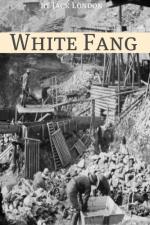|
|
White Fang Topic Tracking: Environment
Environment 1: In this passage, Bill and Henry realize that the she-wolf must have some history as a dog, because she knows how men work and how the food gets passed out. They are able to figure out the she-wolf's familiarity with a civilized environment.
Environment 2: This passage foreshadows the she-wolf's later return to the Indian camp. She has a past among the people of the camp, and has at least some desire to return to them. Her instinct to have cubs and raise them in the Wild overcomes her at this point, but it seems the civilized environment will have a fairly strong hold also.
Environment 3: The gray cub's experience with the river shows how environment and instinct can work together. The cub has an instinctual fear of the unknown and distrust of appearances. This seems to be strengthened greatly by his experience with the river. He mistakes the river for solid land, and ends up cold, wet, and hurt as a result. Perhaps these experiences will strengthen the cub's chances for survival in the future.
Environment 4: The cub's experience with the lynx seems to be a defining moment of his youth. This is the only instance in which his mother is badly hurt, and it is the only time in his childhood that he is obviously put into danger. He is in this danger due to lack of food, which indicates a degree of risk needs to be taken when food is scarce.
Environment 5: White Fang's experiences with his mother allow him to place great value on her, and so he fights for her when she is taken away. She has defined his life up to this point; most of his life has been spent with her and no one else.
Environment 6: White Fang is abused horribly by Lip-lip, and he has to learn to survive. He learns the best way to fight and to deal with the dogs in the Indian camp. He is forced into the position of loner and vicious wolf. He can't seem to befriend any other dog, but rather forces them away for his own protection.
Environment 7: Because of his position as a total outcast, White Fang is forced to learn and grow into a fighting machine. He is cruel and effective. The dogs abuse him, and so he learns to fight back to deal with them.
Environment 8: White Fang is left alone in the Wild, and the reader is shown how his environment at the Indian camp has subordinated his instincts and his earlier experiences. He has grown to accept the world of the camp as it is, and a drastic change such as this leaves him totally out of place. Even though he has lived in the Wild before, he is closest to the most recent experiences of his life.
Environment 9: In his work as head of the sled team, White Fang has to fight a war within himself. His instinct is to turn around and defend himself against the dogs that are chasing him. However, Mit-sah is waiting with a whip to injure him if he does this. He knows the effects of the whip and Mit-sah's ability to use it. He wants to avoid the lashing and so continues running.
Environment 10: As the "Fighting Wolf," White Fang is forced to live a caged life in which all contact is to be despised and reviled. He adapts and becomes fantastic at what he does, becoming cruel and vicious far beyond his days in the Indian camp. However, it seems that his spirit is not broken by the experience.
Environment 11: As Scott attempts to tame White Fang by bringing his hand close, White Fang has been doubly prepared to fight against this. His instinct insists that this is dangerous, and that he must retaliate. He has also been severely abused for a long period of time. White Fang reacts by biting Scott's hand to defend himself.
Environment 12: Although White Fang bit Scott the last time he tried this, Scott has been careful this time. White Fang knows that he should not bite, and he knows on some level that Scott will not harm him. This is enough to prevent him from biting again, even though a large part of him wants to retaliate against the offending hand.
Environment 13: This passage demonstrates how well Scott teaches White Fang. He forces White Fang to recognize his mother's hug as a normal part of human interaction. Certainly, this is important to Scott, so that accidental attacks don't occur. It also seems to change White Fang's perception of people and their environment.
Environment 14: Scott's ability to teach White Fang is demonstrated again, as well as White Fang's amazing ability to learn and adapt. White Fang learns well the lesson of not killing the chickens, and soon this will become as much a routine as all the other rules that are established.
Environment 15: In the case of Jim Hall, the man was not only maltreated in his environment, but also abnormal. The picture of Jim Hall is that of a career criminal, but one must consider how he got to that point. Hall's attempt to kill Judge Scott was justified in his mind because of the police conspiracy involved in his conviction, even though the Judge didn't know about the conspiracy.




